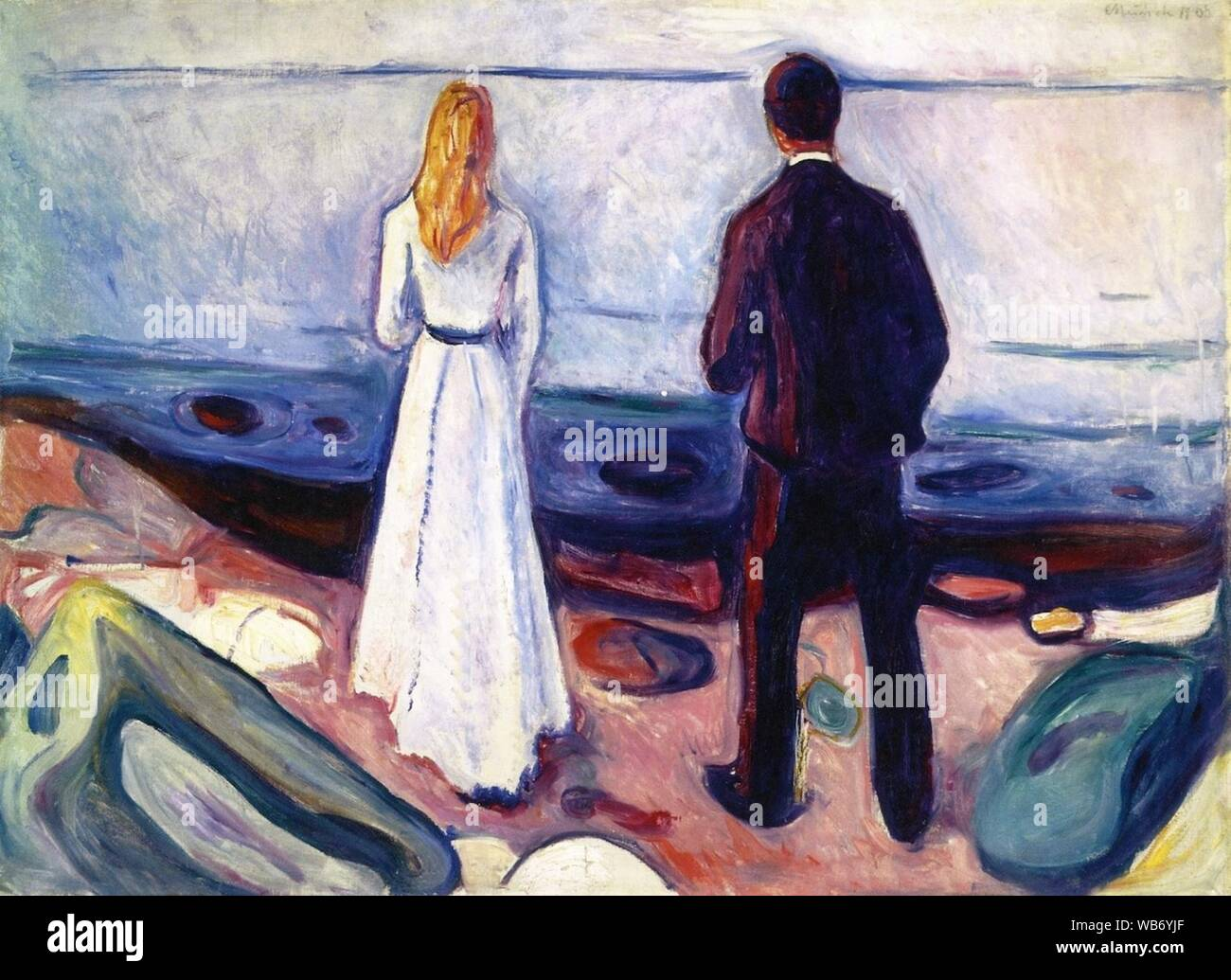
Edvard Munch Two Human Beings: Art’s Exploration of Connection
admin
- 0
Edvard Munch’s masterpiece, “Two Human Beings (The Lonely Ones),” serves as a poignant reflection on the complex nature of human connection and solitude. Featured in the ongoing Edvard Munch exhibition at the Harvard Art Museums, this evocative oil painting reveals a man and woman standing by the shore, embodying both companionship and isolation. Over the course of his illustrious career, Munch revisited this powerful motif multiple times, exploring various interpretations and artistic techniques that have captivated art enthusiasts. The interplay of color and form in Munch’s works, including this piece, elevates the notion of loneliness into an intricate dialogue about relational depth. Exploring themes reminiscent of past explorations, Munch’s artistic journey through pieces like “The Lonely Ones” invites viewers to reconsider their understanding of connection, fostering deeper engagement with his remarkable legacy.
In the realm of expressionist art, Edvard Munch’s “Two Human Beings” stands out as a profound exploration of human relationships and emotional states. The Harvard Art Museums are currently showcasing this iconic work as part of a rich exhibition that delves into the many variations Munch created over the decades. Known for his ability to convey deep psychological nuances, Munch’s paintings, particularly in the motif commonly referred to as “The Lonely Ones,” encapsulate the tension between intimacy and alienation. By frequently revisiting this concept, Munch not only interrogates the essence of companionship but also examines the intricacies of the human condition. As viewers engage with Munch’s artistic exploration, they are invited to reflect on their own intersections of closeness and solitude.
Understanding Edvard Munch’s ‘Two Human Beings’
Edvard Munch’s painting “Two Human Beings (The Lonely Ones),” created between 1906 and 1908, remains one of the most evocative works in modern art. Through this iconic piece, Munch delves into profound themes of human connection and isolation, capturing the essence of the figures standing in stark contrast to the vastness of the sea. The use of oil on canvas allows Munch to manipulate texture and color, creating a visual tension that resonates with viewers. This intense portrayal reflects Munch’s long-standing fixation on the emotional states of his subjects, reminiscent of the artist’s powerful expressionism evident throughout his other works, including prints and woodcuts that feature the same motif over the decades.
The composition of “Two Human Beings” profoundly highlights a juxtaposition: despite the physical proximity of the man and woman, their turned backs suggest a deeper emotional distance. Munch’s exploration of this dynamic prompts viewers to question the nature of companionship. Are these figures truly alone together, or do they share a form of solidarity amidst their isolation? Such interpretations deepen our understanding of the work’s significance within the context of Munch’s broader oeuvre, as seen in essential exhibitions like “Edvard Munch: Technically Speaking” at the Harvard Art Museums.
Frequently Asked Questions
What themes are explored in Edvard Munch’s ‘Two Human Beings (The Lonely Ones)’?
Edvard Munch’s ‘Two Human Beings (The Lonely Ones)’ delves deep into themes of isolation, companionship, and the emotional connection between figures. Though often interpreted as expressions of loneliness, the painting suggests a more complex relationship, intertwining colors and gestures that indicate companionship and contemplation against the backdrop of the sea.
Where can I see Edvard Munch’s ‘Two Human Beings’ exhibition?
You can view Edvard Munch’s ‘Two Human Beings (The Lonely Ones)’ and other works at the Harvard Art Museums as part of the exhibition ‘Edvard Munch: Technically Speaking,’ which runs until July 27, 2025. This exhibition showcases his artistic explorations across various mediums.
What is the significance of the title ‘The Lonely Ones’ in relation to Edvard Munch’s work?
The title ‘The Lonely Ones’ reflects the duality present in Munch’s ‘Two Human Beings.’ While it traditionally symbolizes loneliness, closer analysis suggests that the figures also embody a strong connection to each other and their landscape, inviting interpretations of companionship and shared contemplation.
How did Edvard Munch approach the creation of ‘Two Human Beings’ over his career?
Over 40 years, Edvard Munch revisited the motif of ‘Two Human Beings,’ producing numerous paintings, prints, and woodcut variations. His evolving techniques—from meticulous brushwork to spontaneous strokes—highlight his experimentation with color and form, showcasing the dynamic energy of the figures and their surroundings.
What innovations did Munch employ in the prints of ‘Two Human Beings’?
In his prints of ‘Two Human Beings,’ Munch utilized a jigsaw technique, allowing him to create varied compositions by inking and assembling individual elements separately. This innovative approach led to a multitude of color variations, inviting fresh interpretations of the figures in relation to the landscape.
How does ‘Two Human Beings’ reflect Edvard Munch’s artistic philosophy on imperfection?
Munch celebrated imperfections in ‘Two Human Beings,’ often leaving visible sketch lines and bare patches on the canvas. His willingness to embrace flaws suggests that he viewed them as integral to the emotional depth and authenticity of his work, challenging the notion that perfection is essential for artistic merit.
What impact did Edvard Munch’s psychological experiences have on ‘Two Human Beings’?
While Edvard Munch’s psychological struggles often influenced his work, ‘Two Human Beings’ transcends his personal experiences, encouraging viewers to see his art as a medium for exploration. The recurring motifs reflect not just his inner turmoil but also a profound engagement with emotional themes such as companionship and connection.
How does the Harvard Art Museums contribute to the understanding of Edvard Munch’s ‘Two Human Beings’?
The Harvard Art Museums, through the exhibition ‘Edvard Munch: Technically Speaking,’ provide a platform to explore Munch’s artistic evolution, particularly focusing on ‘Two Human Beings.’ The exhibition contextualizes his works within his broader artistic journey and the various interpretations cultivated over decades.
| Aspect | Details |
|---|---|
| Exhibition Title | Edvard Munch: Technically Speaking |
| Artist | Edvard Munch (1863-1944) |
| Key Work | Two Human Beings (The Lonely Ones) |
| Medium | Oil on canvas |
| Significance | Explores themes of isolation, companionship, and emotional depth in Munch’s work |
| Technique | Utilizes varied painting techniques and printmaking methods to explore the motif |
| Curators | Elizabeth M. Rudy and Lynette Roth |
| Exhibition Duration | Until July 27, 2025 |
Summary
Edvard Munch’s “Two Human Beings” offers profound insight into the artist’s exploration of human connection and isolation. This remarkable work showcases Munch’s dynamic use of color and technique, expanding the conversation around loneliness in relationship dynamics. Through his many iterations of this motif, Munch not only reflected his emotional landscape but also invited viewers to contemplate broader themes of companionship and the human experience. The ongoing exhibition illustrates the impact of “Two Human Beings” as both a personal and universal statement on connection.

